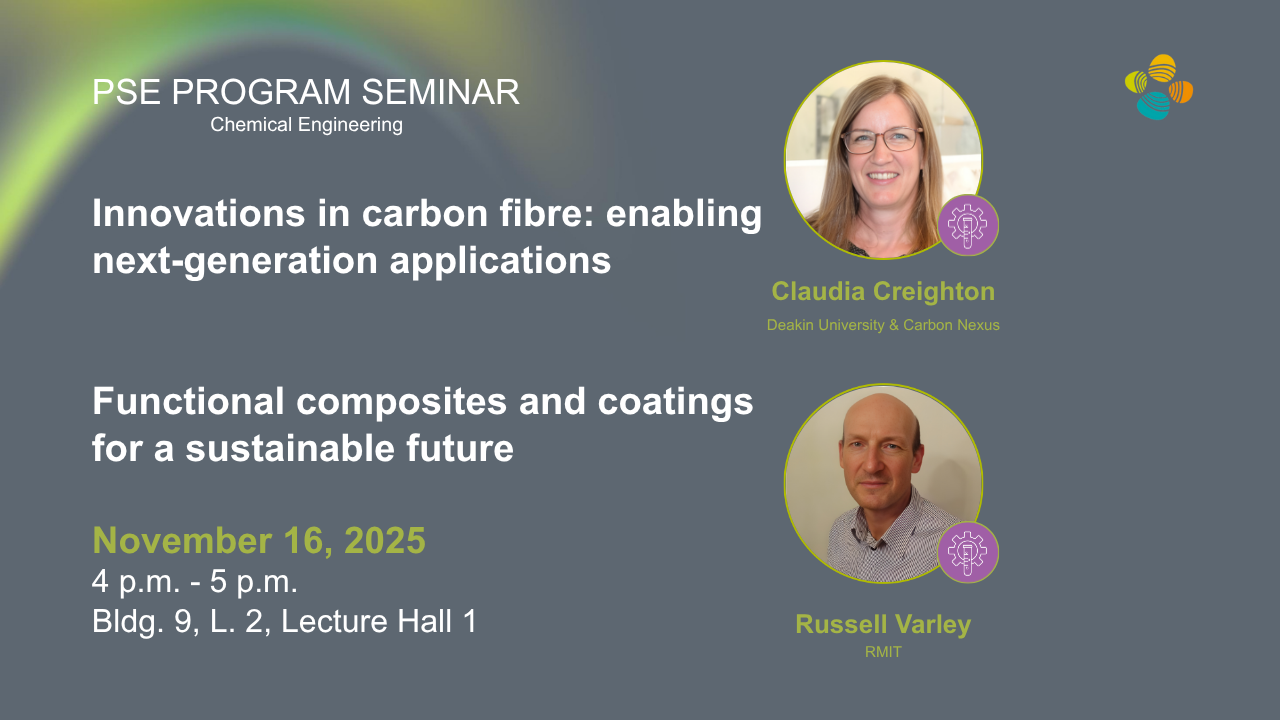Nov 2025
Chemical Engineering Graduate Seminar

Innovations in Carbon fibre: Enabling next-generation applications
By Professor Claudia Creighton – Deakin University & Carbon Nexus, Australia
Abstract
Carbon fiber and their composites are in great demand in many industry sectors due their superior mechanical performance and light-weight properties. The open-access carbon fibre research line at Carbon Nexus, Deakin University (Australia), is a globally unique fibre research facility, supporting industrial-scale development of next generation carbon fibres. This talk introduces the process for developing carbon fibre including the evolution of micro-structure along the carbon fibre production chain, requiring a deep understanding of structure-property relationships. The presentation will cover research topics into tailoring carbon fibres for specific needs in the renewable energy sector and multifunctional purposes, such as structural batteries. Further, the assessment of effect of precursor material and process parameters on energy demand and environmental impact during carbon fibre manufacture using life cycle analysis (LCA) will be discussed.
Biography
Prof. Claudia Creighton is a leader in carbon fiber and composites research at Carbon Nexus at the Institute for Frontier Materials (IFM), Deakin University (Australia).
She has over 15 years of experience working with the aerospace, automotive and wind turbine manufacturing industries making impact at the forefront of advanced carbon fiber and composites manufacturing. Her research interests include the fundamental understanding of the effect of carbon fiber production process on the fiber morphology, sustainable fiber development and the implementation of circular economy principles into carbon fiber manufacturing. Another passion of her is the material recovery from end-of-life (EoL) composite products and life cycle analysis (LCA).
Claudia received her Ph.D. at Deakin University in 2011 in out-of-autoclave composite manufacture in collaboration with Eurocopter (Airbus Helicopters), followed by a post-doctoral researcher position at Deakin University in carbon fiber and advanced composites development.
Publications include:
- Published 44 peer reviewed articles, including 37 referred journal articles, 7 conference papers and contributed to 1 book chapter.
Recognitions:
- Deakin University Vice Chancellor’s award for Industry Engagement in 2016 and 2017, recognizing an outstanding contribution to commercialization of research outcomes.
International JEC Innovation Award for an “Innovative production process in the manufacture of carbon fiber composite parts”.
- Deakin University Vice Chancellor’s award for Industry Engagement in 2016 and 2017, recognizing an outstanding contribution to commercialization of research outcomes.
Functional composites and coatings for a sustainable future
By Professor Russell Varley – RMIT, Australia
Abstract
A new generation of composite materials and advanced coatings are required to address the challenges of a carbon constrained future. From lightweight structures enhancing fuel efficiencies for aircraft, automobiles and trucks, to lowering the cost of renewable energy by enabling improved hydrogen storage and more efficient wind turbine blades. Self-healing materials are an important part of the toolkit to reduce global emissions through enhanced resource efficiencies which lower the overall carbon footprint of a structure or component. This talk will discuss the synthesis and characterization of high-performance bio-based epoxy imine vitrimers as remouldable and weldable composites moving to the synthesis and characterization of room temperature damage activated self-healing coatings based upon boronic esters.
Biography
Prof. Varley earned his B.Sc (Hons) in Physical and Inorganic Chemistry from The University of Adelaide, South Australia in 1987. He then worked for 1.5 years at Yorkshire Chemicals in Melbourne, Victoria, a manufacturer of chemicals for the textile industry, before gaining a position as an experimental scientist at CSIRO in 1989. Since completing his PhD from the Materials Engineering Department at Monash University in 1998, Prof Varley has been using polymer chemistry to develop next generation composite materials through control of the chemical structure and microstructure of polymer networks. His interests include the design of processable, high performance and functional polymer composites, improving the toughness of polymer networks, self-healing materials, vitrimers and fire retardancy. Upon joining Deakin University in 2016, his research directions expanded to include the synthesis of next generation carbon fibre using novel rapid oxidation methods, alternative precursors and novel architectures for enhanced sustainability and structural properties. In 2025 he joined RMIT University where he now leads a portfolio of projects focused on industrially relevant outcomes within the aerospace, automotive, construction, renewable energy and oil and gas sectors of the global economy.